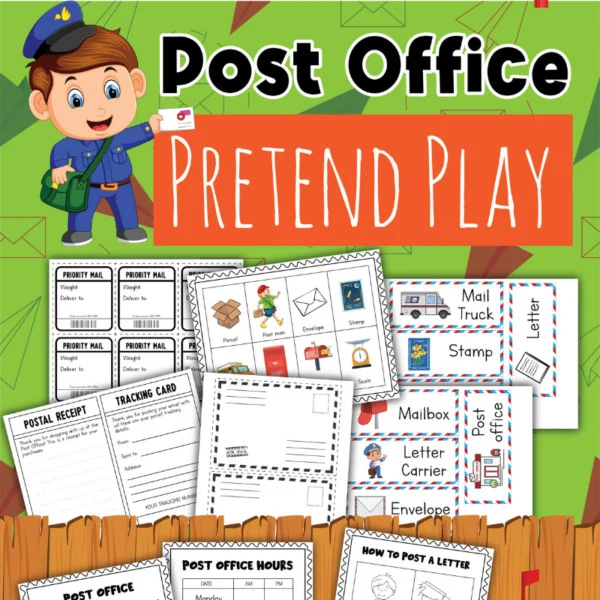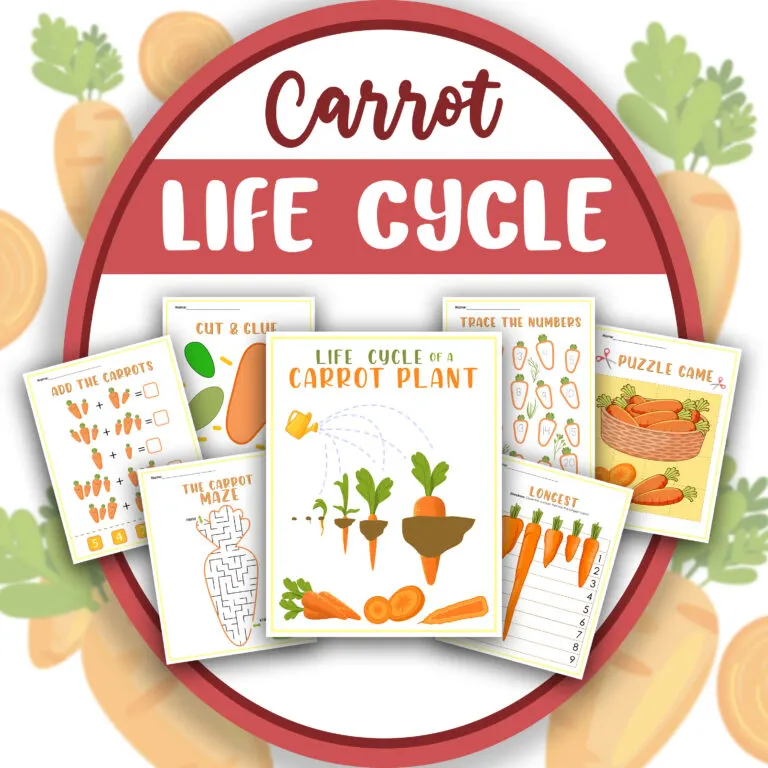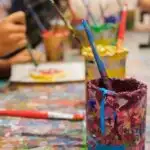The Wacky Painting activity is a fun, engaging, slightly unconventional painting experience designed for children.
Unlike traditional painting sessions, which focus on precisely replicating specific scenes or objects, Wacky Painting encourages kids to let their imaginations run wild. This activity also helps with child development skills – perfect for early learners!
Using a variety of tools—beyond just brushes—such as sponges, fingers, or even pieces of string, children create artworks that are as unique and vibrant as their personalities.
This activity doesn’t just entertain; it’s a celebration of creativity, spontaneity, and the joy of making something unique.

The importance of Wacky Painting in child development cannot be overstated. It is a powerful tool for fostering creativity, an essential skill that benefits children in artistic pursuits, problem-solving, and innovation.
By encouraging them to think outside the box and explore unconventional methods of expression, we’re helping them develop a mindset that values originality and adaptability.
Making wacky paintings isn’t just a fun way to pass the time; it’s super important for kids to do! It helps them grow in all sorts of ways that will be useful when they’re older and need to be creative, flexible, and good at understanding how they and others feel.
Skills Enhanced by this “Wacky Painting Activity“
Wacky Painting supports emotional development by providing a safe outlet for self-expression.
Children can convey feelings and ideas they might not yet have the words to explain, which is crucial for their emotional intelligence and mental health.
The activity’s tactile nature also aids in developing fine motor skills and sensory processing as children manipulate different materials and textures.
Skills Enhanced By This Activity:
Creativity Enhancement
Wacky Painting supports creativity enhancement by encouraging children to explore their imagination and express themselves through art.
This creative outlet allows them to experiment with colors, shapes, and textures, fostering an environment where they can freely generate and develop new ideas.
Children can learn to think outside the box, problem-solve, and develop a sense of artistic identity by creating their unique paintings.
Creativity: Imagine a child using wacky painting to create a vibrant underwater world with colorful fish and swirling seaweed. This creative endeavor enhances their ability to conceptualize an idea visually and encourages storytelling and imaginative thinking.
Gross Motor Skills Enhancement
Engaging in painting activities also enhances gross motor skills. As children manipulate paintbrushes, mix colors, and reach across the canvas, they refine their coordination and dexterity.
Additionally, the physical act of painting may involve standing, reaching, and moving around, contributing to balance and spatial awareness.
Gross Motor Skills: Consider a scenario where children engage in collaborative mural painting, using large brushes and various movements to cover a large canvas. This activity promotes teamwork and communication and helps them refine their hand-eye coordination and balance.
These skills are valuable for children as they can be applied to academic learning, real-life problem-solving, and future career paths requiring creativity and physical coordination.
Materials Needed for Wacky Painting Activity
These materials are handpicked to spark creativity and create fun and excitement, inspiring kids to get creative and think in new, imaginative ways when expressing themselves through art.
Paint: Kids need paint to let their creativity flow. It’s like the magic wand they use to create their masterpieces.
With paint, they can mix and match colors, try out different textures, and let their imagination run wild. It’s super important for them to have this freedom to express themselves.
Safe Alternatives to Traditional Paint
These safe alternatives can ensure that the Wacky Painting activity remains accessible and enjoyable for children, even if traditional painting materials are not available or suitable.
- Non-Toxic Homemade Paints
- Vegetable Dyes
- Edible Finger Paints
Fly Swatter: Unconventional tools can add excitement and unpredictability to painting. One such tool is a fly swatter. When dipped in paint, the fly swatter can create unique patterns and textures on the canvas. This encourages children to explore different techniques for artistic expression and can lead to some truly stunning creations.
Butcher Paper: Butcher paper provides a large, unrestricted canvas for children to work on. Its generous size allows for uninhibited movement and exploration, empowering children to freely engage in the painting process without feeling confined by space limitations.
Additionally, butcher paper’s sturdy nature makes it suitable for various painting techniques, including using fly swatters without tearing or buckling.
Instructions for Wacky Painting Activity
These step-by-step instructions, tips, and suggestions aim to create an engaging and thrilling “Wacky Painting” experience for children, fostering creativity, experimentation, and pure artistic enjoyment.
Setting Up the Butcher Paper:
If using a clothesline outside, secure the butcher paper to the line using clothespins, ensuring it’s taut and doesn’t droop.
If laying the paper flat on the lawn, use heavy objects or stakes to secure the corners and prevent the wind from affecting the painting surface.
Prepare the Paint and Tools:
Pour various colors of paint into shallow containers.
Introduce various unconventional painting tools, such as different types of swatters, sponges, or even toy cars with wheels to create unique patterns.
Demonstrate Painting Techniques:
Show the children how to dip their chosen tools into the paint and transfer the paint onto the butcher paper.
Encourage them to experiment with different techniques, such as splattering, dragging, or stamping, to create diverse textures and patterns.
Encourage Creativity and Exploration:
Emphasize the importance of creativity and expression, letting the children know they can explore and create without limitations.
Celebrate the Artwork:
Once the paintings are complete, allow the artwork to dry, and then proudly display the finished masterpieces for all to see.
Learning Printables and Activities
These are excellent resources for kids! They’ll love being a part of the learning process from start to finish.



Challenge and Fun Enhancements:
Introducing a color-mixing challenge to children is an engaging and fantastic educational opportunity. By encouraging them to blend different paints directly on the paper, we provide a hands-on experience that stimulates their creativity and curiosity.
This challenge helps them understand primary and secondary colors and how combining them can create a new spectrum of shades.
It’s an exploratory process that enhances their cognitive development, teaching them about cause and effect as they predict and see the results of their color-mixing experiments.
This activity fosters decision-making and problem-solving skills as they figure out how to achieve the color they envision.
Adding a fun enhancement to the painting activity, such as using spray bottles filled with water, takes their learning experience to another level.
Spraying water over the paint introduces them to the concept of texture and the interplay between water and paint. It shows how water can diffuse and blend colors on the paper, creating unique patterns and effects that are visually stimulating.
This method adds a layer of excitement and unpredictability to the activity and teaches children about the properties of different materials and how they interact with each other.
It’s a playful way to introduce basic principles of science, such as the solubility of paint in water while encouraging artistic expression and sensory exploration.
Through these activities, children learn to appreciate the beauty of imperfection and the serendipity of art, fostering a love for creative experimentation.
Safety Precautions for Wacky Painting Activity
By emphasizing the use of non-toxic materials and implementing these safety measures, the Wacky Painting activity can be conducted securely and enjoyably, ensuring the well-being of the participating children.
It’s crucial to use non-toxic, washable paints that children can handle. Ensuring the use of non-toxic materials is essential for the safety of the young participants.
Ventilation:
If the activity is conducted indoors, ensure the painting area is well-ventilated to minimize exposure to paint fumes. If possible, consider conducting the activity outdoors or in a well-ventilated room.
Organized Painting Area:
Keep the painting area organized and free from tripping hazards. Ensure that all painting materials and tools are stored safely when not in use.
Supervision:
Supervise the activity closely to prevent accidental misuse of painting materials and tools. This will help maintain a safe environment for the children while they engage in the creative process.
Benefits of Wacky Painting Activity
The “Wacky Painting” activity can significantly contribute to a child’s physical and cognitive development by incorporating physical movement and creative expression.
Here’s how this activity enhances a child’s development, along with relevant sources:
Physical Development:
Engaging in the Wacky Painting activity involves various physical movements, such as reaching, stretching, and manipulating art tools, which can contribute to developing fine motor skills.
These movements help children develop hand-eye coordination, dexterity, and control over their hand movements.
Additionally, unconventional painting techniques, such as with feet or whole-body movements, can enhance gross motor skills and physical coordination, promoting overall physical development.
Cognitive Development:
The role of Wacky Painting in enhancing a child’s creativity is significant. Allowing children to explore different painting techniques, experiment with colors, and express their imagination freely stimulates their creativity and nurtures their cognitive abilities.
It encourages problem-solving, decision-making, and critical thinking as children choose how to use the materials and express themselves artistically.
The Wacky Painting activity is valuable in fostering holistic development in children by providing a platform for physical movement, creative expression, and cognitive stimulation.
Other Similar Activities
These activities can be conducted in various settings, including schools, childcare centers, or at home.
They offer opportunities for children to engage in imaginative play, physical movement, and creative expression, fostering holistic development while having fun.
Here are some other activities that can enhance creativity and gross motor skills in children, along with a brief overview of each:
Obstacle Course Creations:
Overview: Children can design and build obstacle courses using everyday items like cushions, hula hoops, or tunnels. This activity encourages creativity in course layout and promotes physical movement to navigate obstacles.
Conducting the Activity: Children can collaborate to create the obstacle course, placing items strategically to form challenges like crawling under tables, jumping over obstacles, and balancing on makeshift beams. Supervision ensures safety during the activity.
Dance and Movement Exploration:
Overview: Dancing and movement activities allow children to express themselves creatively through music and physical movements. It enhances gross motor skills by promoting coordination, rhythm, balance, and spatial awareness.
Conducting the Activity: Create an open space for the children to move freely, play lively music, and encourage them to explore different dance styles, movements, and rhythms. Incorporating simple dance games or following choreographed routines can add an element of fun and learning.
Sensory Play with Playdough:
Overview: Sensory play with playdough provides opportunities for children to engage in hands-on creativity and fine motor skill development. The tactile experience of manipulating playdough supports sensory exploration and fosters imaginative expression.
Conducting the Activity: Offer a variety of playdough colors and tools for children to mold, shape, and create their sculptures, objects, or scenes. Encourage imaginative play and storytelling as they interact with the playdough.
DIY Craft Projects:
Overview: Engaging in do-it-yourself (DIY) craft projects, such as making paper crafts, collages, or simple sculptures, allows children to explore various art mediums and materials while enhancing creativity and fine motor skills.
Conducting the Activity: Provide a range of art supplies, recycled materials, and age-appropriate tools for children to create their DIY crafts. Encourage them to experiment with different textures, colors, and techniques to bring their ideas to life.

Parents, consider engaging in the Wacky Painting activity and other creative endeavors with your children to foster their physical and cognitive development while creating cherished memories.
These activities provide valuable opportunities for quality bonding and shared experiences that can positively impact your child’s growth.
Participating in these activities nurtures their creativity and motor skills and strengthens their relationship through collaborative and enjoyable moments.
Take the time to join your children in exploring the world of art, movement, and imaginative play. Embrace the messiness and spontaneity of these activities, and celebrate the unique creations that emerge from your collective efforts.
Your active involvement can ignite their passion for creative expression and physical exploration, instilling confidence and a sense of accomplishment in their developing minds.
The joy of these activities lies not only in the result but also in the process itself. Emphasize the value of creativity, experimentation, and self-expression, encouraging your children to freely explore their ideas and movements within a safe and supportive environment.


















